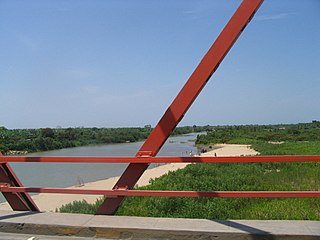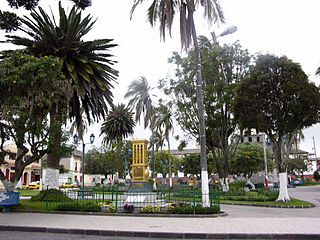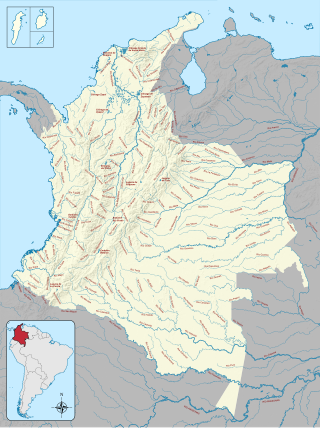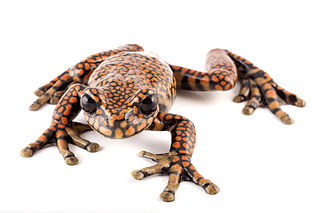
Imbabura is a province located in the Andes of northern Ecuador. The capital is Ibarra. The people of the province speak Spanish, and a large portion of the population also speaks the Imbaburan Kichwa variety of the Quechua language.

The green terror is a colorful freshwater fish in the cichlid family. The fish originates from the Pacific side of South America from the Tumbes River in Peru to the Esmeraldas River in Ecuador. It is polymorphic and can have white or gold-orange edging to the tail and dorsal fins. It has historically been confused with two other species that always have narrow, clearly defined white edging, the more southerly distributed A. stalsbergi and the more northerly A. blombergi.

Barbacoan is a language family spoken in Colombia and Ecuador.

The Tumbes River, is a river in South America. The river's sources are located between Ecuadorian El Oro and Loja provinces. It is the border between El Oro and Loja, and afterwards the border between Loja and the Tumbes Region in Peru. At its confluence with the Cazaderos stream, it enters the northern coastal region of Peru called the Tumbes Region, and flows into the Pacific Ocean outside the Gulf of Guayaquil. The largest city on its banks is Tumbes, Peru.
The Esmeraldas River is a 210 km (130 mi) river in northwestern Ecuador that flows into the Pacific Ocean at the city of Esmeraldas. Among its tributaries is the Guayllabamba River which drains Quito. Charles Marie de la Condamine sailed up it and then climbed the Andes Mountains when on the Ecuadorian Expedition that left France in May 1735.

Cotacachi is a canton of Imbabura province of Ecuador in South America. The name also refers to Cotacachi (city), the seat of that canton, which is one of Ecuador's leading artisanal manufacturers of leather goods, and to the dormant Cotacachi Volcano which overlooks the canton.

Cotacachi Cayapas Reserve contains 752,235 acres (3,044 km2) of land and is located in the Imbabura and Esmeraldas provinces of Ecuador 87 miles (140 km) from Quito. Elevations in the reserve range from about 300 metres (980 ft) in the east to Cotacachi Volcano which reaches an elevation of 4,944 metres (16,220 ft) in the southwest. This nature reserve is partly rainforest. The park is a mix of many biological zones but the Andean and Sub-tropical zones are most common. The symbol of the reserve is a condor. This is one of the many protected areas in Ecuador.
Cha'palaa is a Barbacoan language spoken in northern Ecuador by ca. 3000 ethnic Chachi people.

The blue acara is a colorful freshwater fish in the cichlid family. This fish can be found in various freshwater habitats, ranging from standing water to flowing streams, in Venezuela and Trinidad. They can reach lengths of 16 cm (6.3 in). The scientific species name is indicative to its looks; pulcher meaning "beautiful" in Latin. The blue acara is a common cichlid sold in many aquarium stores, and is sometimes confused with the larger green terror.

Andinoacara is a genus of fish in the family Cichlidae. The genus was described in 2009. Before this the members of Andinoacara were placed in the "catch-all" genus Aequidens although they are not closely related to the other members of this genus. The genus Andinoacara is restricted to freshwater habitats in northwestern South America and southern Central America. There are no members of the genus in the Amazon Basin.

The Baudó River is a river of Colombia. It drains into the Pacific Ocean.

The San Juan River is an important river of Colombia that flows into the Pacific Ocean through the Chocó Department. It is approximately 380 kilometres (240 mi) and drains a watershed of 16,000 square kilometres (6,200 sq mi). The river drains into a large delta that covers nearly 300 square kilometres (120 sq mi). The average discharge of the Rio San Juan is 2,054.67 m³/s.

The Prince Charles stream tree frog is a species of frogs in the family Hylidae found in Ecuador. It is considered an endangered species threatened by habitat loss, climate change, pathogens, and other hazards.
Chachi people are an ethnic group who live in the rainforest area of northwestern Esmeraldas on the northern coast of Ecuador. They live by the Cayapas River in the Centro El Encanto, a section of the Cotacachi Cayapas Ecological Reserve, as do Afro Ecuadorian people; the two groups have co-existed in the forest for about 400 years. There were approximately 5,000 Chachi in 2003.
Andinoacara stalsbergi is a species of South American freshwater fish in the family Cichlidae. It was previously included in A. rivulatus, but was described as a separate species in 2009. The specific name honours the Norwegian aquarist Alf Stalsberg who collected the type of this species and who has had a “longstanding commitment to increase the knowledge about cichlid fishes”.

Orcés’s long-tongued bat is a species of leaf-nosed bat found in Ecuador.
Andinoacara sapayensis, the Sapayo cichlid, is a species of fish in the family Cichlidae in the order Perciformes, found on the South American Pacific slope, in the Cayapas River drainage in northwestern Ecuador.
Andinoacara blombergi, is a species of fish in the family Cichlidae in the order Perciformes, found on the South American Pacific slope, in the río Esmeraldas drainage in northwestern Ecuador.












